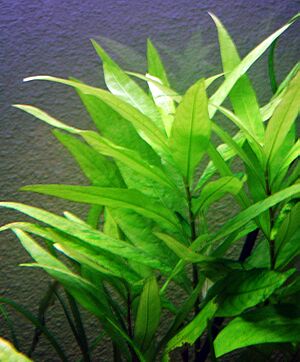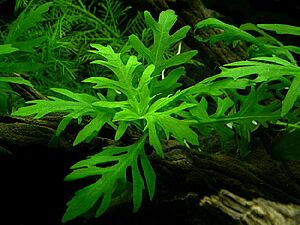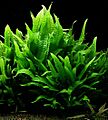List of ornamental aquatic plants in Venezuela facts for kids
Did you know that many beautiful plants you see in aquariums come from places like Venezuela? These special plants grow in water and are called ornamental aquatic plants. People love to use them to make their fish tanks look amazing and provide a natural home for fish. This article will tell you about some of these cool plants found in Venezuela.
Contents
- Amazing Aquarium Plants from Venezuela
- What Are Aquatic Plants?
- Plant Families You Might See
- Acanthaceae Family
- Alismataceae Family
- Araceae Family
- Araliaceae Family
- Cabombaceae Family
- Haloragaceae Family
- Primulaceae Family
- Hydrocharitaceae Family
- Lythraceae Family
- Menyanthaceae Family
- Nymphaeaceae Family
- Onagraceae Family
- Pteridaceae Family
- Plantaginaceae Family
- Polypodiaceae Family
- Saururaceae Family
- Scrophulariaceae Family
- Images for kids
Amazing Aquarium Plants from Venezuela
Aquatic plants are super important for a healthy aquarium. They help keep the water clean by using up waste products from fish. They also produce oxygen, which fish need to breathe. Plus, they give fish places to hide, explore, and even lay their eggs.
What Are Aquatic Plants?
Aquatic plants are plants that have adapted to live in water. Some float on the surface, some are fully submerged, and others grow with their roots in the water and their leaves above. The plants we're talking about here are often used in aquariums because they are beautiful and help create a balanced environment.
Plant Families You Might See
Plants are grouped into "families" based on how they are related. Think of it like your own family, but for plants! Here are some of the plant families that have members commonly found in Venezuelan waters and used in aquariums:
Acanthaceae Family
This family includes plants like Hygrophila corymbosa and Hygrophila difformis. Hygrophila difformis is also known as Water Wisteria. It's a popular plant because it grows quickly and has pretty, lacy leaves. It's great for beginners in the aquarium hobby.
Alismataceae Family
Many plants from the Echinodorus group, often called "Amazon Swords," belong to this family. They are very popular in aquariums because they have strong roots and can grow quite large, making a great centerpiece. Examples include Echinodorus bleheri and Echinodorus cordifolius. Another plant from this family is Sagittaria graminea, which has long, grass-like leaves.
Araceae Family
One plant from this family that you might find in aquariums is Cryptocoryne affinis. Cryptocorynes are known for their varied leaf shapes and colors, and they can be a bit slow to grow at first, but once they settle in, they are very hardy.
Araliaceae Family
Hydrocotyle leucocephala, also known as Brazilian Pennywort, is a plant from this family. It has round, coin-shaped leaves and can grow quickly, either floating or rooted in the substrate. It's often used as a mid-ground or background plant in aquariums.
Cabombaceae Family
The Cabomba furcata is a delicate-looking plant with feathery leaves. It's known for its beautiful reddish color under good lighting, which adds a splash of color to any tank.
Haloragaceae Family
Myriophyllum mattogrossense is a fine-leaved plant that looks like a green feather boa underwater. It's often used to create a dense, bushy look in the aquarium.
Primulaceae Family
Hottonia palustris, or Water Violet, is a unique plant with finely divided leaves that form a beautiful rosette. It's not as common as some other aquarium plants but is very attractive.
Hydrocharitaceae Family
This family includes some very common aquarium plants like Egeria densa (Anacharis or Brazilian Waterweed) and Vallisneria americana (Jungle Val). Egeria densa is a fast-growing plant that's great for beginners and helps keep water clean. Vallisneria has long, ribbon-like leaves that sway gently in the water, creating a natural look.
Lythraceae Family
Rotala rotundifolia is a popular stem plant from this family. It's known for its ability to turn reddish or pinkish under strong light, making it a favorite for adding color to planted tanks.
Menyanthaceae Family
Nymphoides humboldtiana is a plant with lily-pad-like leaves that float on the surface. It can add a different texture and look to the top of your aquarium.
Nymphaeaceae Family
This is the family of water lilies! Many beautiful species like Nymphaea amazonum, Nymphaea caerulea, and Nymphaea lotus are found here. These plants often have large, round leaves that float on the surface and can produce stunning flowers. Victoria amazonica is also part of this family, famous for its giant lily pads that can support a small child!
Onagraceae Family
The Ludwigia genus is well-represented in this family, with species like Ludwigia repens. Many Ludwigia plants are known for their vibrant red and orange colors, especially when given good light and nutrients. They are excellent for adding contrast to a green aquarium.
Pteridaceae Family
Ceratopteris thalictroides, or Water Sprite, is a fern that can grow very large and bushy. It's a fantastic plant for providing hiding places for fish and fry (baby fish). It can also float on the surface.
Plantaginaceae Family
Bacopa caroliniana is a sturdy stem plant with thick, oval leaves. It's relatively easy to care for and can add a nice green background to your tank.
Polypodiaceae Family
Microsorum pteropus, commonly known as Java Fern, is one of the most popular aquarium plants. It's very hardy and can be attached to rocks or driftwood instead of being planted in the substrate. Its dark green leaves provide a great contrast to other plants.
Saururaceae Family
Saururus cernuus, or Lizard's Tail, is a unique plant that can grow both submerged and emersed (partially out of water). It has heart-shaped leaves and can be an interesting addition to a tank.
Scrophulariaceae Family
Bacopa monnieri, or Moneywort, is another easy-to-grow stem plant. It has small, round leaves and can create a dense, bushy look. It's also known for its use in traditional medicine!
These are just some of the amazing aquatic plants that come from Venezuela. They play a vital role in keeping aquariums healthy and beautiful, bringing a piece of the natural world into our homes.
Images for kids










